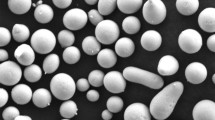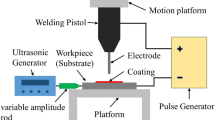Abstract
To enhance the friction and wear properties of Al 6061 machined surface, a surface modification solution by high-speed wire electrical discharge machining (HS-WEDM) with emulsion-based SiC nanofluid dielectric was proposed. A composite coating was formed on the substrate surface, and its surface topography, chemical composition, surface roughness, microhardness, and friction behavior were studied using SEM, EDS, FT-IR, OM, and machined surface performance tests. The results show that the composite coating formed in situ on the surface of the Al 6061 is a double-layer structure consisting of a recast and a covering layer, which exhibit superior biological properties. The wear rate is reduced by 92% compared to the substrate, and the friction coefficient is reduced to less than 0.2 for both Al alloys machined in emulsion and emulsion-SiC nanofluids. In addition, the wear lifetime of samples machined in emulsion-SiC nanofluids is increased by a factor of 25 compared to those machined in emulsion, which is attributed to the superior wear resistance of the coating due to its superior toughness, strong bearing capacity, and self-lubricating properties.












Similar content being viewed by others
Data availability
All data generated or analyzed during this study are included in this published article.
References
Amirkhanlou S, Ji S (2020) Casting lightweight stiff aluminum alloys: a review. Crit Rev Solid State Mater Sci 45(3):171–186. https://doi.org/10.1080/10408436.2018.1549975
Bhatta L, Pesin A, Zhilyaev AP, Tandon P, Kong C, Yu H (2020) Recent development of superplasticity in aluminum alloys: a review. Metals 10(1). https://doi.org/10.3390/met10010077
Lin Y-C, Chen J-N, Huang Y-C, Jian Y-H (2015) Wear and friction characteristics of surface-modified aluminium alloys. Int J Surf Sci Eng 9(2-3):109–123. https://doi.org/10.1504/ijsurfse.2015.068236
Sahoo B, Das T, Paul J (2022) Thermal spraying and related technologies for the surface modification of al alloys: review. Surf Rev Lett 29(9). https://doi.org/10.1142/s0218625x2230009x
Zhang J, Song B, Wei Q, Bourell D, Shi Y (2019) A review of selective laser melting of aluminum alloys: processing, microstructure, property and developing trends. J Mater Sci Technol 35(2):270–284. https://doi.org/10.1016/j.jmst.2018.09.004
Devyatkina TI, Luchneva SI, Vasin EN, Cherkashev NA, Isaev VV, Belyaev ES et al (2020) Surface preparation of aluminum alloys for electroplating. Russ J Appl Chem 93(9):1372–1379. https://doi.org/10.1134/s1070427220090098
Samir HA, Qian HC, Xia BC, Wu SM (2004) Comments on process of duplex coatings on aluminum alloys. J Cent S Univ Technol 11(3):239–245. https://doi.org/10.1007/s11771-004-0049-7
Li D-l, Li C-w, Chen H, Tian C-l (2022) Preparation of microarc oxidation coating containing graphene combined with micro-arc oxidation and electrophoretic deposition. Mater Chem Phys 290. https://doi.org/10.1016/j.matchemphys.2022.126598
Bhat KU, Panemangalore DB, Kuruveri SB, John M, Menezes PL (2022) Surface modification of 6xxx series aluminum alloys. Coatings 12(2). https://doi.org/10.3390/coatings12020180
Dai Y, Yan L, Hao J (2022) Review on micro-alloying and preparation method of 7xxx series aluminum alloys: progresses and prospects. Materials 15(3). https://doi.org/10.3390/ma15031216
Kuo C, Kao H, Wang H (2017) Novel design and characterisation of surface modification in wire electrical discharge machining using assisting electrodes. J Mater Process Technol 244:136–149. https://doi.org/10.1016/j.jmatprotec.2017.01.025
Liew PJ, Yap CY, Wang J, Zhou T, Yan J (2020) Surface modification and functionalization by electrical discharge coating: a comprehensive review. Int J Extreme Manuf 2(1). https://doi.org/10.1088/2631-7990/ab7332
Abdudeen A, Abu Qudeiri JE, Kareem A, Ahammed T, Ziout A (2020) Recent advances and perceptive insights into powder-mixed dielectric fluid of EDM. Micromachines 11(8). https://doi.org/10.3390/mi11080754
Eakambaram A, Xavior MA (2019) Influence of recast layer on the fatigue life of Ti6Al4V processed by electric discharge machining. Arch Metall Mater 64(4):1541–1548. https://doi.org/10.24425/amm.2019.130124
Li C, Xu X, Li Y, Tong H, Ding S, Kong Q et al (2019) Effects of dielectric fluids on surface integrity for the recast layer in high speed EDM drilling of nickel alloy. J Alloys Compd 783:95–102. https://doi.org/10.1016/j.jallcom.2018.12.283
Zhang Y, Liu Y, Ji R, Cai B (2011) Study of the recast layer of a surface machined by sinking electrical discharge machining using water-in-oil emulsion as dielectric. Appl Surf Sci 257(14):5989–5997. https://doi.org/10.1016/j.apsusc.2011.01.083
Adnan M, Qureshi W, Umer M, Botto D (2022) Tribological characterization of electrical discharge machined surfaces for AISI 304L. Materials 15(3). https://doi.org/10.3390/ma15031028
Chakraborty S, Mitra S, Bose D (2022) Performance characterization of powder mixed wire electrical discharge machining technique for processing of Ti6Al4V alloy. Proc Inst Mech Eng E-J Process Mech Eng 236(4):1283–1295. https://doi.org/10.1177/09544089211060722
Sivaprakasam P, Hariharan P, Gowri S (2019) Experimental investigations on nano powder mixed Micro-Wire EDM process of inconel-718 alloy. Measurement 147. https://doi.org/10.1016/j.measurement.2019.07.072
Mughal MP, Farooq MU, Mumtaz J, Mia M, Shareef M, Javed M et al (2021) Surface modification for osseointegration of Ti6Al4V ELI using powder mixed sinking EDM. J Mech Behav Biomed Mater 113. https://doi.org/10.1016/j.jmbbm.2020.104145
Amorim FL, Dalcin VA, Soares P, Mendes LA (2017) Surface modification of tool steel by electrical discharge machining with molybdenum powder mixed in dielectric fluid. Int J Adv Manuf Technol 91(1-4):341–350. https://doi.org/10.1007/s00170-016-9678-x
Kumar V, Sharma N, Kumar K, Khanna R (2018) Surface modification of WC-Co alloy using Al and Si powder through WEDM: a thermal erosion process. Part Sci Technol 36(7):878–886. https://doi.org/10.1080/02726351.2017.1317308
Babu JAR, Kumar KK, Rao SS (2017) State-of-art review on hybrid nanofluids. Renew Sustain Energy Rev 77:551–565. https://doi.org/10.1016/j.rser.2017.04.040
Devendiran DK, Amirtham VA (2016) A review on preparation, characterization, properties and applications of nanofluids. Renew Sustain Energy Rev 60:21–40. https://doi.org/10.1016/j.rser.2016.01.055
Leong KY, Ahmad KZK, Ong HC, Ghazali MJ, Baharum A (2017) Synthesis and thermal conductivity characteristic of hybrid nanofluids - a review. Renew Sustain Energy Rev 75:868–878. https://doi.org/10.1016/j.rser.2016.11.068
Murshed SMS, Estelle P (2017) A state of the art review on viscosity of nanofluids. Renew Sustain Energy Rev 76:1134–1152. https://doi.org/10.1016/j.rser.2017.03.113
Minea AA (2019) A review on electrical conductivity of nanoparticle-enhanced fluids. Nanomaterials 9(11). https://doi.org/10.3390/nano9111592
Haddad Z, Abid C, Oztop HF, Mataoui A (2014) A review on how the researchers prepare their nanofluids. Int J Therm Sci 76:168–189. https://doi.org/10.1016/j.ijthermalsci.2013.08.010
Murshed SMS, Leong KC, Yang C (2008) Thermophysical and electrokinetic properties of nanofluids - a critical review. Appl Therm Eng 28(17-18):2109–2125. https://doi.org/10.1016/j.applthermaleng.2008.01.005
Li X, Li X, Li Y, Dong C, Tian H, Wang S et al (2019) Growth mechanism of micro-arc oxidation film on 6061 aluminum alloy. Mater Res Express 6(6). https://doi.org/10.1088/2053-1591/ab0a20
Guo C, Wu Z, Wang X, Zhang J (2021) Comparison in performance by emulsion and SiC nanofluids HS-WEDM multi-cutting process. Int J Adv Manuf Technol 116(9-10):3315–3324. https://doi.org/10.1007/s00170-021-07600-7
Lee G-S, Shin Y-H, Kim J-M, Kim T-S, Lee Y-Z (2009) Frictional characteristics of nano-scale mesoporous SiO2 thin film formed by sol-gel and self-assembly method. J Nanosci Nanotechnol 9(12):7340–7344. https://doi.org/10.1166/jnn.2009.1784
Wang Q, Cao Y, Li J, Li J, Shang W, Peng N et al (2022) Construction of hydrophobic lauric acid film on aluminum alloy and its corrosion resistance mechanism. Surf Interface Anal 54(9):1008–1019. https://doi.org/10.1002/sia.7126
Hua Q, Zeng Y, He Z, Xu Q, Min Y (2020) Microstructure, synergistic mechanism and corrosion behavior of tin oxide conversion film modified by chitosan on aluminum alloy surface. Colloid Interface Sci Commun 36. https://doi.org/10.1016/j.colcom.2020.100262
Zhang Y, Wang Y, Li C, Zhou B, Cheng K, Wei Y (2018) Preparation and corrosion resistance of the ZnAl-LDHs film on 6061 Al alloy surface. Acta Metall Sin 54(10):1417–1427. https://doi.org/10.11900/0412.1961.2018.00020
Huang W, Li D, Zheng T, Guo M (2006) A novel anti-corrosion coating for aluminum alloy. In: Poole WJ, Wells MA, Lloyd DJ (eds) Aluminium Alloys 2006, Pts 1 and 2: research through innovation and technology. Materials Science Forum, pp 519–521
Pagnoux G, Fouvry S, Peigney M, Delattre B, Mermaz-Rollet G (2015) Influence of scratches on the wear behavior of DLC coatings. Wear 330:380–389. https://doi.org/10.1016/j.wear.2014.12.010
Su F, Zhang S (2014) Tribological properties of polyimide coatings filled with PTFE and surface-modified nano-Si3N4. J Appl Polym Sci 131(12). https://doi.org/10.1002/app.40410
Shapovalov VM, Valenkov AM, Buyakov IF (2011) Effect of ultradispersed particles of structured carbon on deformation and strength characteristics and tribological behavior of polyamide coatings. J Frict Wear 32(6):467–471. https://doi.org/10.3103/s1068366611060122
Funding
This study was supported in part by grants from Supported by the Opening Project of Material Corrosion and Protection Key Laboratory of Sichuan province (2021CL21), the National Natural Science Foundation of China (51301115), and Graduate Innovation Fund of Sichuan University of Science & Engineering (y2021030).
Author information
Authors and Affiliations
Contributions
Cuixia Guo: methodology, validation, data curation, and writing—original draft
Wenling Xie: formal analysis, investigation, conceptualization, resources, methodology, and supervision
Sheng Lai: review and editing
Xing Wang: writing—review and editing
Corresponding author
Ethics declarations
Ethical approval
Not applicable.
Consent to participate
Written informed consent was obtained from individual or guardian participants.
Consent for publication
Not applicable.
Competing interests
The authors declare no competing interests.
Additional information
Publisher’s note
Springer Nature remains neutral with regard to jurisdictional claims in published maps and institutional affiliations.
Rights and permissions
Springer Nature or its licensor (e.g. a society or other partner) holds exclusive rights to this article under a publishing agreement with the author(s) or other rightsholder(s); author self-archiving of the accepted manuscript version of this article is solely governed by the terms of such publishing agreement and applicable law.
About this article
Cite this article
Guo, C., Wang, X., Xie, W. et al. Surface modification of aluminum alloy by wire electrical discharge machining with SiC nanofluid dielectric. Int J Adv Manuf Technol 127, 3525–3536 (2023). https://doi.org/10.1007/s00170-023-11771-w
Received:
Accepted:
Published:
Issue Date:
DOI: https://doi.org/10.1007/s00170-023-11771-w




